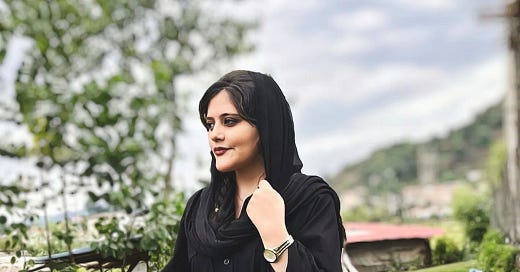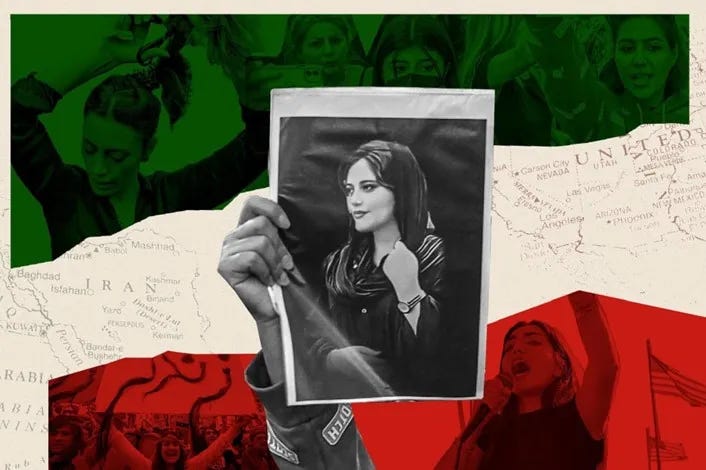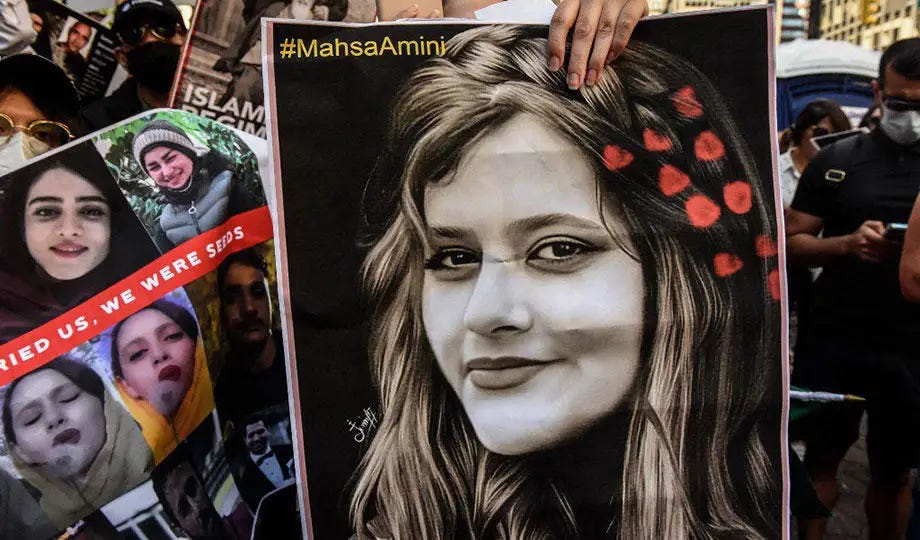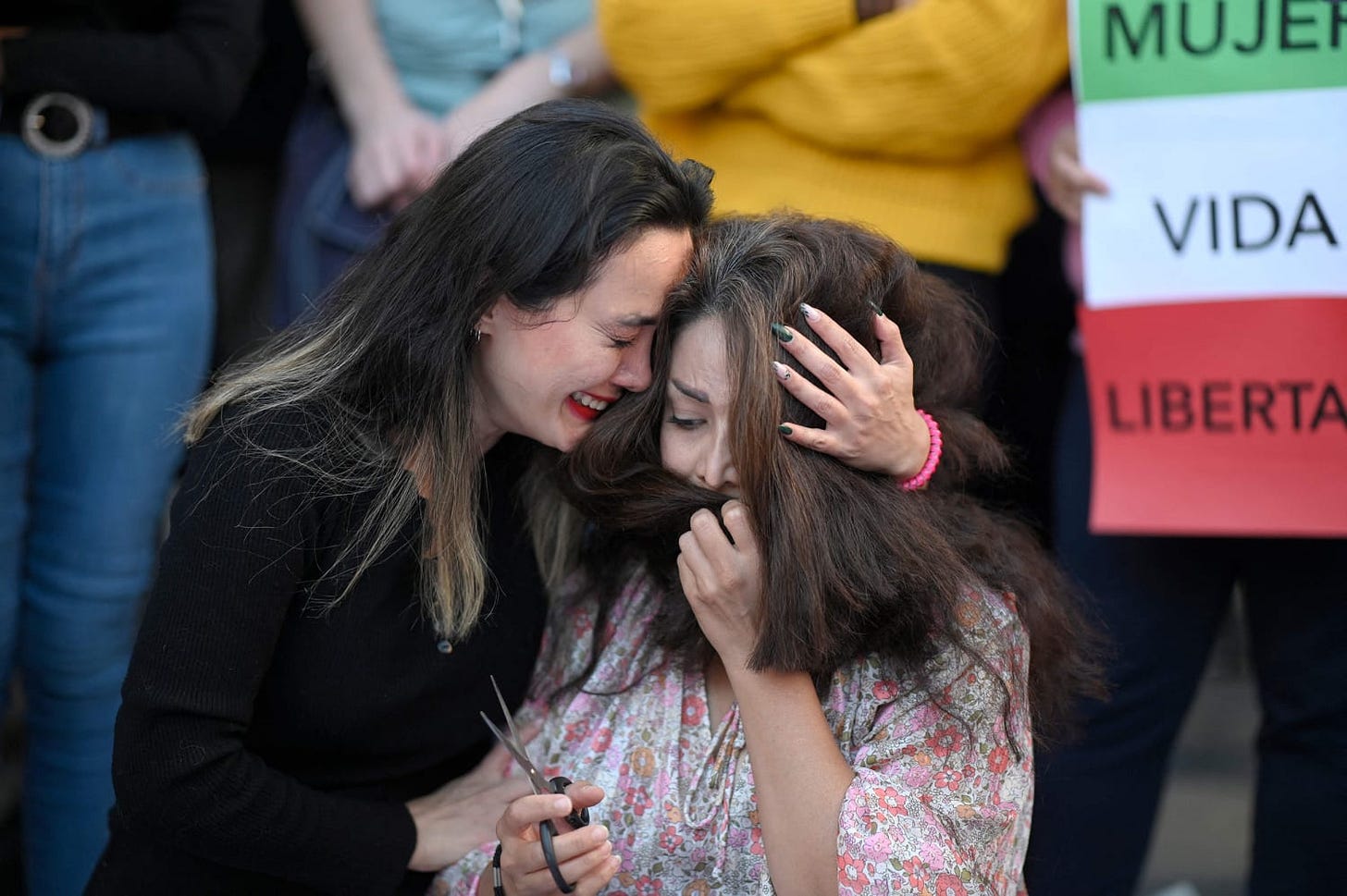From Mahsa Amini to the Gaza Strip:
How US foreign policy and Israeli intervention fuel the oppression of women in Iran and across the Middle East.
Jina Mahsa Amini in 2022. Photo credit: Britannia.com.
NOTE: Nazia Saeed, a Human Resources professional living in Abu Dhabi, United Arab Emirates, researched and wrote most of this article.
**********
Mahsa Amini (left — before her September 2022 arrest, and right — in a hospital after Iran’s Gašt-e Eršād (“Guidance Patrol” or “Morality Police”) attacked her in Tehran, Iran. Image source: unknown.
As Israel continues to conduct a US taxpayer-funded mass genocide, military-induced famine, and ethnic cleansing of Gaza, with tacit approval from the Trump administration, we think it is essential to return once again to Mahsa Amini’s death for context on what the future likely holds for the Palestinians in Gaza.
Public Health Policy Reviews has dedicated a lot of column space to the tragic 2022 death of Mahsa Amini. Our first article on Mahsa Amini’s death at the hands of Iran’s notorious Gašt-e Eršād (Guidance Patrol–or “Morality Police”) was posted on May 9th, 2024.
The first essay was the fourth installment in a five-part series examining 20 Years of US Military Imperialism in the Middle East.
**********
Image credit: 19thnews.org.
The second article about Mahsa Amini, published on August 23rd, 2024, connected her death to the implications of US Middle East policy, especially regarding Israel’s invasion of Gaza, in shaping our forecast that Donald Trump was likely to secure a second term as US president in November 2024.
Amid the Israeli Defense Force’s (IDF) constant mass killings of starving Palestinians, Israel, and AIPAC, their powerful lobbying apparatus in the United States, have begun openly calling for America to “do something” about Iran.
As Israel intensifies its efforts to involve the US in confrontations with Iran, pointing to worries about Iran’s nuclear ambitions, it is crucial to raise a more profound question: Who pays the price when the two countries engage in military aggression in the Middle East?
The response to American and Israeli violence in the region, unfortunately, frequently highlights the profound suffering of Middle Eastern women and girls.
**********
From Protest to Propaganda: The Risk of Co-Opting Mahsa Amini’s Legacy.
A September 2022 protest against the arrest and death of Mahsa Amini at the Brunel University of London in Great Britain. Image credit: Brunel University of London.
Iran’s “Morality Police” arrested twenty-two-year-old Mahsa Amini in Tehran, Iran, on September 13th, 2022.
Ms. Amini was detained for allegedly wearing her hijab improperly. She was dead within days.
Mahsa Amini’s brutal death ignited a wave of protests across Iran and abroad, led by women demanding the most basic of freedoms: to choose how they dress, how they live, and whether they are allowed to be free. In the aftermath of Mahsa Amini’s death, US and Israeli officials were quick to condemn Iran’s regime and voice solidarity with Iranian women.
Although it was simple for diplomatic officials and feminist activists from North America and Western Europe to depict Iran’s treatment of women and girls solely a result of Islamic religious extremism or domestic authoritarianism, these groups and individuals overlooked the devastating influence of international geopolitics—especially the extensive reach of US foreign policy—in supporting the systems and extremist groups that enable such oppression.
**********
The Gendered Fallout of Decades of US Sabre-Rattling and Economic Sanctions.
In 2018, Iranian clerics Sadeq Amoli Larijani (center) and Hassan Khomeini (right) in Tehran, Iran. Image credit: Mohammed Hassanzedeh and Tasnim News Agency.
Since the 1979 Iranian Revolution and the hostage crisis that followed, Iran has been one of America’s most persistent geopolitical adversaries.
Religious extremists and politically conservative hardliners within the Iranian regime have used American political hostility and Israeli military interventions to justify cracking down on civil liberties and women’s rights in Iran.
The Ayatollahs, high-ranking Shia Islamist clerics who have held the role of “Supreme Leader” since 1979, argue that liberalization is a Western plot and that protecting the nation means enforcing stricter religious codes and tighter social controls. In this twisted logic, the mandatory hijab becomes not just a piece of clothing but a symbol of resistance against foreign imperialism.
Successive US administrations, Democrat and Republican alike, have imposed crippling economic sanctions on the country, often under the banner of nuclear non-proliferation or human rights. But these policies have had perverse, unintended consequences—or consequences deemed acceptable collateral damage.
**********
Moral Contradictions in the United States and Western Europe.
Protesters grieve during a demonstration in Madrid, Spain, in support of Mahsa Amini in October 2022. Photo credit: Oscar del Pozo and the AFP via Getty Images.
The harsh irony is that the US, which asserts its role as a global advocate for women’s rights, frequently undermines them via its foreign policy.
International financial sanctions imposed by the US government and Western European countries rarely affect powerful economic and social elites. Instead, the sanctions decimate the economic lifelines of ordinary citizens. In Iran, women are disproportionately affected.
Inflation and unemployment hit Iranian women the hardest. Sanctions on medical supplies mean that access to reproductive health care has declined. Women working in public-facing industries have been pushed out as the Iranian economy has contracted over the past forty years.
The cultural space that briefly bloomed in the early 2000s for Iranian women to write, perform, and advocate has been crushed under economic despair and a harsh conservative political and religious extremist backlash.
Two years on, the echoes of Amini’s name have not faded, but the hope of change within Iran has grown dimmer. The Shia Islamic regime remains firmly in power, and the machinery of repression grinds on.
**********
Image credit: Albert Stoynov on Unsplash.
The hypocrisy is not lost on Iranian citizens.
By backing authoritarian allies such as Saudi Arabia, known for its unique form of gender apartheid, and by accepting Israel’s misconduct in the occupied territories, the US government relinquishes any moral high ground it may assert while criticizing Iran.
When both the Biden-Harris and Trump administrations urge the US Congress to provide funding and arms to oppressive regimes that marginalize women domestically and internationally while imposing sanctions on Iran, their professed commitment to gender rights seems insincere at best and cynical at worst.
Furthermore, US military interventions in the region—from Iraq to Afghanistan—have left power vacuums and humanitarian crises that disproportionately impact women. With each drone strike, with each toppled regime, the chaos that follows often erodes any gains women might have made.
The Iranian government, watching from across the Persian Gulf, uses this US and Israeli-imposed regional instability to argue that Western-style reform leads only to bloodshed.
**********
A Call for Consistency and Courage.
A woman holds an Iranian flag during an anti-Israeli gathering in Tehran on April 19th, 2024. Israel retaliated against Iran on April 19th for its drone-and-missile assault on Israel a week earlier. Photo credit: Vahid Salemi and the Associated Press (AP).
Military “hawks” in the US and Israel are framing Iran’s gender apartheid as another reason for war.
War rarely liberates women. It kills them, makes orphans of their children, leaves female survivors subject to sexual slavery, gender violence, and domestic abuse – and destabilizes their communities for generations.
Two years have passed since Mahsa Amini became a symbol of resistance for women and girls in Iran, across the Middle East, and abroad. Mahsa Amini’s death revealed not just the brutality of the Iranian regime but also the deep yearning for dignity among its people, gender equality, and freedom for its female population.
Women’s rights and educational opportunities for girls cannot be fulfilled through economic sanctions, bombing campaigns, or geopolitical grandstanding. The disingenuous and culturally elitist beliefs of White Western feminists used Mahsa Amini and the voices of Iranian women as regional pawns in an international chess match to extoll their perceptions of racial, cultural, religious, and national superiority.
Gender advocacy and female solidarity must move beyond ideological grandstanding and media propaganda.











